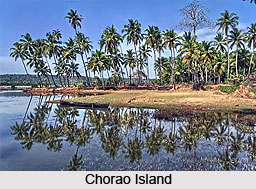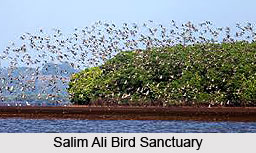 Chorao Island is an island along the Mandovi River near Panaji of Goa. Chorao Island was called "chudamani", meaning stunning precious stone in Sanskrit. Local legends narrate the history of the islands emerging from the diamonds that were thrown away by Yashoda the mother of Lord Krishna. The Islanders call it chodan or chodna. It was the Portuguese who called it Chorao. The Portuguese noblemen were the founders of the Chorao Island and created it as a pleasurable place to live. Thus, the place derived its name as "Ilha Dos Fidalgos" (Island of Noblemen).
Chorao Island is an island along the Mandovi River near Panaji of Goa. Chorao Island was called "chudamani", meaning stunning precious stone in Sanskrit. Local legends narrate the history of the islands emerging from the diamonds that were thrown away by Yashoda the mother of Lord Krishna. The Islanders call it chodan or chodna. It was the Portuguese who called it Chorao. The Portuguese noblemen were the founders of the Chorao Island and created it as a pleasurable place to live. Thus, the place derived its name as "Ilha Dos Fidalgos" (Island of Noblemen).
The ten families of Goud Saraswat Brahmins were amongst the aborigine settlers of the Chorao Island. The island was said to be a place of learning and also boasts a Sanskrit University. According to the Hindu deities and Temples by Rui Pereira Gomes, the island had ancient temples of Ganesh, Devki, Ravalnath, Kanteshwar, Mallinath, Bhaukadevi, Bhagwati, Narayan,
 Santa-purush, Chandeshwar and Dadd-sancol. Also Vanadevata and Roulu on Caroi Vado. When the Portuguese began to force Christianity in the Goan islands, many Hindus fled from chudamani and shifted Hindu idols via Mayem to Naroa and Marcela. The main deity Devaki-Krishna and its associated deities of Bhumika Devi, Mallinath, Laxmi Ravalnath, Katyayani, Chodaneshwar and Dhada Shankar were taken to Mayemwadem in Bicholim and then moved to its present location at Marcel. The Jesuits Christianised the island as they also followed this the Island of Divar and salsette (Saxti).
Santa-purush, Chandeshwar and Dadd-sancol. Also Vanadevata and Roulu on Caroi Vado. When the Portuguese began to force Christianity in the Goan islands, many Hindus fled from chudamani and shifted Hindu idols via Mayem to Naroa and Marcela. The main deity Devaki-Krishna and its associated deities of Bhumika Devi, Mallinath, Laxmi Ravalnath, Katyayani, Chodaneshwar and Dhada Shankar were taken to Mayemwadem in Bicholim and then moved to its present location at Marcel. The Jesuits Christianised the island as they also followed this the Island of Divar and salsette (Saxti).
Chorao Island constituted of three communidades, namely the Chorao - GSB Vangors, Ambelim - GSB and Daivajna vangors and Caroi- 3 Daivajna vangors. A seminary called the Real Colegio De Educacao De Chorao was established in April 1761. A temple of Shri Devaki Krishna Bhumika Mallinath was rebuilt on 11 January 1934.
Amongst the Christian places of worship in Chorao Island is the Church of St Bartholemew. The other church is the Church of Our Lady of Grace. Chorao Island is also home to the Salim Ali Bird Sanctuary. Hindus and Christians live peacefully today on this emerald island. Bird species including little heron, Indian pond heron, western reef heron, pintail, white-bellied sea eagle, black eagle, grey plover, lesser pied kingfisher, little ringed plover, common sandpiper, gull-billed tern, common kingfisher and white-breasted kingfisher can be found there. Chorao Island is the home of the world famous Salim Ali Bird Sanctuary.



















